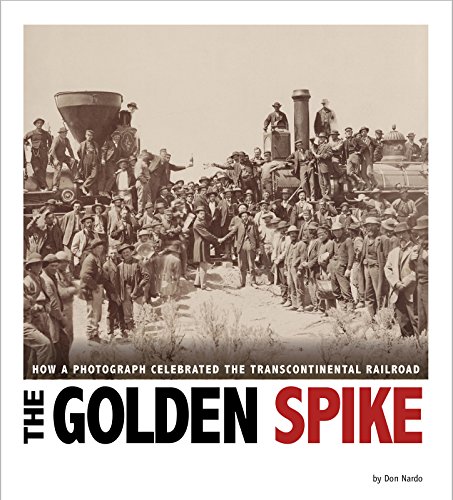-
The Stone Age
Patricia D. Netzley
Library Binding (Lucent Books, Jan. 1, 1998)Discusses the long period of human history known as the Stone Age during which humans evolved into beings capable of inventing and using increasingly sophisticated tools and creating complex social groupings
-
The Enlightenment
John M. Dunn
Library Binding (Lucent Books, Jan. 1, 1999)Discusses various aspects of the Enlightenment including its roots, philosophes, attacks on Christianity, revolt against reason, campaigns to reform society, and legacy.
-
Face of Freedom: How the Photos of Frederick Douglass Celebrated Racial Equality
Emma Carlson-Berne
Library Binding (Compass Point Books, Aug. 1, 2017)Frederick Douglass, abolitionist, writer, political activist, reformer has been called the most important African-American of the 1800s. He was also the most photographed American of the 1800s. Douglass, who escaped enslavement to work tirelessly on behalf of his fellow African-Americans, realized the importance of photography in ending slavery and achieving civil rights. The many portraits of Douglass showed the world what freedom and dignity looked like. Z
Z
-
World History: Test Practice and Review Workbook Ancient through Early Modern Times
MCDOUGAL LITTEL
Paperback (MCDOUGAL LITTEL, March 26, 2008)None
-
Hitler's Reich
Gail Stewart
Library Binding (Lucent Books, Jan. 1, 1994)Traces the rise to power of Adolph Hitler and discusses life in Nazi Germany before, during, and after World War II Z+
Z+
-
Black Power Salute: How a Photograph Captured a Political Protest
Danielle Smith-Llera
Paperback (Compass Point Books, Jan. 1, 2017)Two American athletes made history at the 1968 Summer Olympics, but not on the track. They staged a silent protest against racial injustice. Tommie Smith and John Carlos, gold and bronze medalists in the 200-meter sprint, stood with heads bowed and black-gloved fists raised as the national anthem played during the medal ceremony. The Australian silver medalist wore a human rights badge in support. All three would pay a heavy price for their activism. A Life magazine photograph seen by millions would ensure that the silent protest was remembered, and eventually admired, as a symbol of the battle for equality and civil rights. Z
Z
-
The Golden Spike: How a Photograph Celebrated the Transcontinental Railroad
Don Nardo
Library Binding (Compass Point Books, Jan. 1, 2015)In the mid-1860s, as the Union Pacific Railroad headed westward from Nebraska, another company, the Central Pacific, pushed eastward from California. Their goal was to meet somewhere in between, forming a single railway line that would bridge the continent. That historic meeting took place in May 1869 in northern Utah, and photographer Andrew J. Russell was there to document the historic event. His work resulted in one of the most important photos of the 19th century and probably the most famous railroad image of all time. The photo, often called “East and West,” was viewed by a worldwide audience and affirmed that railroads were at the cutting edge of transportation technology. The continent was now linked. Y
Y
-
Roman Empire
Don Nardo
Hardcover (Lucent, Sept. 30, 2005)Traces the history of the Roman Empire from the days of the Republic, through the reign of the Caesars and the influence of Christianity, to the fall of Rome. W
W
-
Serena vs. Venus: How a Photograph Spotlighted the Fight for Equality
Danielle Smith-Llera
Paperback (Compass Point Books, Jan. 1, 2017)The final match of the 2001 U.S. Open featuring tennis stars Venus and Serena Williams was groundbreaking. It was first time siblings had squared off in the final match for more than 100 years. And it was the first time both players were black. The photo of the smiling Williams sisters holding their trophies after the tennis match appeared in newspapers around the globe. It captured two athletes who fought, and would continue to fight, for a place for women and African-Americans in tennis and the world beyond. Y
Y
-
Greek and Roman Mythology
Don Nardo
Library Binding (Lucent Books, Sept. 1, 1997)Examines the historical development of Greco-Roman mythology, its heroes, and its influence on the history of Western civilization
-
Civil War Witness: Mathew Brady's Photos Reveal the Horrors of War
Don Nardo, Bob Zeller
Library Binding (Compass Point Books, July 1, 2013)Mathew Brady recognized that the new art of photography could be more than just a means of capturing people's likenesses in portraits. Beginning with the First Battle of Bull Run in 1861 and continuing through the entire Civil War, Brady and his employees chronicled the long, bloody conflict, bringing images of war directly to the people. Brady knew the photos would create valuable historical records for later generations. More than any other photographer of his generation, Brady understood photography's great potential and through his influence, he taught others to understand it as well. Z
Z
-
Internet-Linked Encyclopedia of the Roman World
Jane Bingham, Fiona Chandler, Sam Taplin
Hardcover (Usborne Pub Ltd, Sept. 30, 2001)Usborne Internet-Linked World History is a series of lavishly produced reference works, which will be of interest to children and adults alike. Value is added to this book with a comprehensive 30-page fact-finder section, packed with useful information including a who's who, time chart, guide to Roman sites, glossary, map of the empire, military formations, lists of gods and goddesses and a full index.